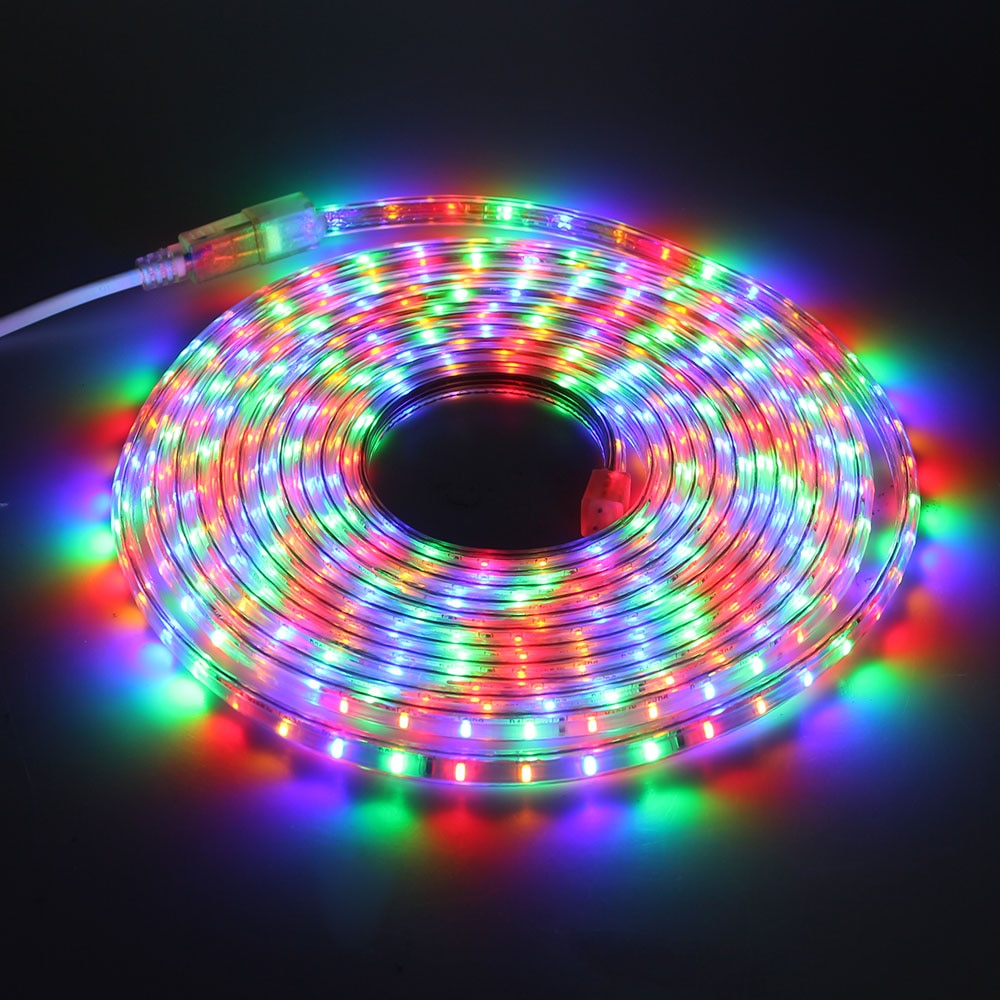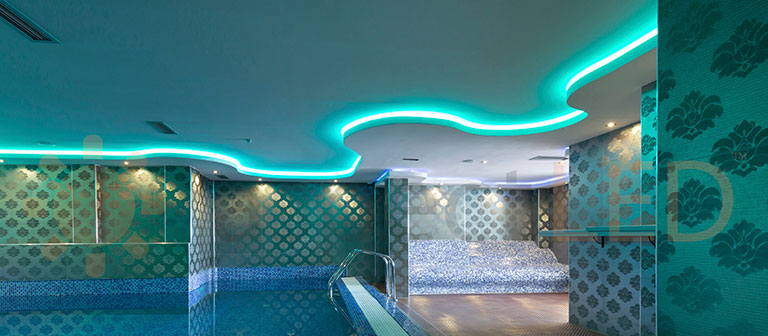What LED strip lights consist of?
LED strip lights are usually made up of a number of small, light-emitting diodes (LEDs) mounted on a flexible backing material. The LEDs are connected in series so that when one turns on, the entire strip lights up. When powered LEDs will emit light in specific colors depending on the size and quality of LED chips used.
What do red, green, blue mean for LED strip lights?
Light-emitting diodes are semiconductor devices that emit light when a forward voltage is applied across their leads. The color of the emitted light depends on the bandgap of the material used to make up the diode. LEDs can be made in many different colors. However, color-changing LEDs will only emit light in specific frequencies (or wavelengths) corresponding to electron transition levels in certain materials (i.e., transition metal compounds).
Add A Creative Touch With Multicolor LED Strips
These frequencies correspond to energy values referred to as quanta, which means you get out what you put in - meaning that there are no wasted photons! Depending on the size and quality of LED chips that are used, these energies can vary by several electron volts.
This is why LEDs are able to emit light in specific colors. For example, an LED made with a material that has a bandgap of 1.9 electron volts will emit light with a wavelength of 620 nanometers - in the red part of the visible spectrum. An LED with a bandgap of 2.8 electron volts will emit light at a wavelength of 470 nanometers - in the blue part of the visible spectrum.
What could cause my LED strip lights to change colors by themselves randomly?

There are a few things that could cause your LED strip lights to change colors by themselves. One possibility is that the color-changing function has been activated and is now randomly cycling through all the colors available.
Another possibility is that there may be a problem with the connection between the LEDs or with the power supply. If this is the case, it may be necessary to resolder or replace the faulty part.
A few other possibilities you might consider too are:
- The AC power going into your house or business may be faulty. This can be checked by plugging in a different device that is known to work and see if the same happens to it. If this is true, then there must be something wrong with the external power coming from the wall socket to which your LED strip lights connect.
- Your LEDs may have been damaged during installation or transport, simply replace them!
Why don't my multiple-colored led lights change colors anymore?
If your LED strip lights no longer change colors, it could just mean that you need new ones. Replacing some part of your setup (e.g., re-doing any soldering) could also fix the issue. There may also be something wrong with the power supply, or you might just have to remove and reinsert your batteries (if it is a battery-powered setup).
Why do only some of my LEDs light up randomly?
If only certain sections of your LED strip lights are lit up, check for breaks or damaged sections in the cables connecting them together. If there are no visible damages, however, it could mean that one of the wiring connections has worked loose - check this by removing each connection from its socket on both ends and then remaking all the connections again.
Common reasons that may make LED strip lights work incorrect:
- Damaged LEDs: If you see any visible damage on the LED strip lights, they will need to be replaced.
- Poor connection: Inspect the solder points and make sure that they are all clean and making good contact. You can also try resoldering them if needed.
- Incorrect voltage: Make sure that the LED strip light is getting the correct voltage before trying to fix anything else.
- Bad wiring: If there are any breaks in the wiring, it will need to be fixed or replaced.
- Defective power supply: A bad power supply could be causing your LED strip lights to change colors by themselves. Try replacing the power supply if possible.
- Improper installation (damaged strip lights, wrong voltage, or current): If you are using LED strip lights in your project, make sure that they are the correct type for what you are doing. Also, make sure that you are using the right voltage / current supply with your LEDs. You may need to send them back if there is something wrong with them before attempting to fix anything else.

- Faulty AC power entering your house or office: This can be checked by plugging in a different device that is known to work and seeing if the same happens to it. If this is true, then there must be something wrong with the external power coming from the wall socket to which your LED strip lights connect.
- Windows Media Player: If you are using Windows Media Player to change the colors on your LED strip lights, it could be that the program has frozen or stopped working correctly. Closeout of the program and try restarting your computer.
- The wrong type of LEDs used: Make sure that you are using the right type of LEDs for your project. Not all LEDs will work for every project. For example, if you are trying to light up a sign, you will need to use high-density LEDs in order for the sign to be able to support itself.
- LED strips are overheating: over time, LED strips can overheat. If this is the case, try using a lower wattage power supply or change the location of your LED strip lights.
- The color sequence has been changed: If you have previously set a custom color sequence for your LED strip lights and they have since reverted back to their default colors, it could be that the controller you are using has stopped working or been damaged. Try replacing the controller if possible.
- Surface and position: LED strip lights will emit less light when they are positioned at a greater angle from the surface on which they are placed. To make them emit more light, position them closer to the horizontal plane on which you want them to be visible and then secure or fasten them into place.
- LEDs receiving power: If it seems like your LED strips aren't receiving any power (e.g., despite being plugged in), check that all of the connections between each section of LEDs are secure and functional - this includes checking for accidental breaks inside each section of LED strip lighting.
How to make my LED strip lights work correctly?
Turn the power off and unplug all cables to your LED strip lights, before removing each connection from its socket on both ends and then remaking all the connections again.
Make sure that you are using the right type of LEDs for your project. Not all LEDs will work for every project. For example, if you are trying to light up a sign, you will need to use high-density LEDs in order for the sign to be able to support itself.
Inspect the solder points and make sure that they are clean and making good contact with the wire coming out of it. You can also try resoldering them if needed. Make sure that you are using the right voltage / current supply with your LEDs. Also, make sure that you are using the right type of LED strip lights for your project.
Your LEDs could be overheating: over time, LED strips can overheat. If this is the case, try using a lower wattage power supply or change the location of your LED strip lights.
Check that all connections between each section of LEDs are secure and functional - this includes checking for accidental breaks inside each section of LED strip lighting.
To check if Windows Media Player has stopped working correctly, open up another program such as Google Chrome or Mozilla Firefox and see if it happens there too. If so, then reinstall Windows Media Player by following these steps: go to "control panel" > "add/remove programs" > find Windows Media Player in the list and click "uninstall."
After restarting your computer, download the latest version of Windows Media Player from Microsoft's website and install it.
If you have previously set a custom color sequence for your LED strip lights and they have since reverted back to their default colors, it could be that the controller you are using has stopped working or been damaged. Try replacing the controller if possible.

How much power does my set-up require?
You can find out how much energy your specific LED setup uses by dividing the total wattage of your system by 1,000 (i.e., a 20 W power supply system will have a use rate of 0.02 kW). The resulting figure is the number of hours that your set up will function ideally when it is fully charged.
Can I use a dimmer to change the brightness of my LED strip lights?
While it is possible to use a dimmer with LED strip lights, it is not always recommended. This is because most dimmers do not emit enough power to control LEDs without causing them to flicker or produce less light. If you are determined to use a dimmer with your LED strip lights, make sure that you purchase one specifically made for LEDs and test it with your setup before permanently installing it.
If you are using a power supply that is lower than the LEDs require, it will result in a decrease in light output and a longer life for your LEDs. Conversely, if you are using a power supply that is higher than the LEDs require, it will result in an increase in light output but a shorter life for your LEDs.
Can I use my LED strip lights outdoors?
While it is possible to use LED strip lights outdoors, they should not be directly exposed to water or moisture. In order to use them outdoors, try protecting them with a water-resistant sealant or by placing them inside of an enclosure such as a weatherproof box. It is also important to make sure that the power supply you are using is rated for outdoor use and that there is a GFCI nearby.
Bottom line
There are a few things you can do to troubleshoot why your LED strip lights are changing colors by themselves. These include checking the solder points, making sure all connections are secure, reinstalling Windows Media Player, replacing the controller, and using a power supply that is rated for outdoor use.
If you have tried all of these solutions and your LED strip lights are still not working correctly, then it is possible that there is something wrong with the LEDs themselves. In this case, you may need to replace them.






